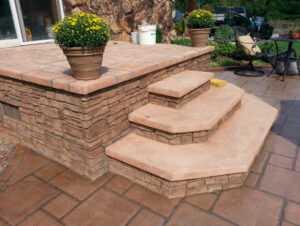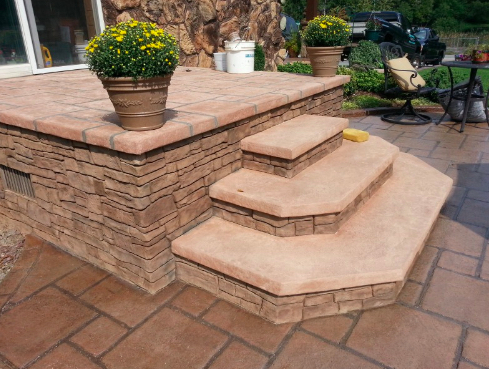 Your entryway is the focal point of your home, so it’s important to design a functional space that’s welcoming and organized. Shelves, cubbies, and cabinets hold jackets, shoes, purses, and bags, while trays, hooks, corral keys, and other frequently misplaced items.
Your entryway is the focal point of your home, so it’s important to design a functional space that’s welcoming and organized. Shelves, cubbies, and cabinets hold jackets, shoes, purses, and bags, while trays, hooks, corral keys, and other frequently misplaced items.
A retaining wall is ideal for sloped front yards because it keeps soil, plants, and mulch in place while stopping dirt from sliding down sidewalks and streets during rainy weather. The retaining walls look great with many concrete styles and finishes. Click https://concretecontractorcoloradosprings.com/ to learn more.
A path is a critical piece of your front garden that connects the public landscape of your home or business with its private interior space. It creates a transition from the street or sidewalk to your front door, offering visitors an easier route for a peaceful and unified feel. The way you plot your path will greatly impact its success, with straight paths offering efficiency and a formal feel and winding ones providing a more tranquil approach.
The first step in planning your pathway is determining its purpose and location. For example, a primary path receiving heavy foot traffic should be made from a material set firmly in place and providing an even, non-slip surface. Loose materials, such as shredded bark mulch or pine needles, are not ideal near an entryway because they can cause people to track dirt inside the house. However, they are fine for a secondary, more casual walkway leading to your front door from a garden area to the mailbox.
When selecting your path material, consider how you want it to look and how easy maintenance will be. For example, if you choose a temporary material like wood chips or pebbles, you may need to refresh them regularly as they decompose and wear away. A more permanent surface, such as concrete or flagstone, will cost more but last longer and require less frequent refreshment.
For a more traditional option, concrete pavers with a brick or stone look can offer an elegant and timeless look that complements many types of homes and businesses. For a bolder style, try a darker stone pattern that contrasts the light of your landscaping.
Stamped concrete is an excellent choice for sidewalks and entryways. It looks similar to the real thing and requires less maintenance than other materials, such as pavers or asphalt. It also provides a solid surface that is safe for foot traffic, even in bad weather. The design options are endless, and your contractor can recommend specific stamp patterns to fit the style of your home or business.
A concrete walkway can extend from a driveway or garage door to a front porch, patio, pool deck, or backyard garden area. It can be curved or straight, with or without a ramp for wheelchair access. It can look like flagstone, brick, cobblestone, or a wood plank design. It can even incorporate a concrete flower bed with a raised planter or bench. You can match the definite pattern to other elements in your outside entertainment area, such as a cement outdoor fireplace or retaining wall that resembles brick or stone.
Contractors use large flexible polyurethane stamps to imprint the concrete with a textured design. Various stamps are available, including real stone molds that replicate flagstone, slate, and high-end stone tiles. Wood stamps also range from smooth, narrow planks to gnarly extra wide for a rustic or farmhouse look in light to dark wood tones.
Once the stamped concrete is installed, adding color for consistency and realism is a good idea. The contractor can add color to the concrete as it’s mixed or spray it on afterward. Many people layer an accent color on top of the integral base color to achieve tone variations and highlight details in the concrete pattern.
A decorative concrete entryway will enhance the curb appeal of your property, and it’s a great way to greet your guests with an attractive welcome. It’s also more affordable than alternatives and will last years with minimal maintenance. Working with a professional is important, as errors on a stamped concrete project can be expensive and difficult to repair. To avoid costly mistakes, get several bids from contractors and check references before hiring one to do the job.
Retaining walls are an important element in a residential entryway or business entrance. They add curb appeal and a sense of anticipation and serve a functional purpose by keeping soil and plants in place and stopping dirt from sliding down onto sidewalks or streets when it rains. They can be made of on-site concrete, pre-cast wall sections, or a concrete block system. Regardless of the material, retaining walls must be engineered by professional engineers and constructed with proper footings to ensure safety and structural integrity.
Decorative concrete is one of the most popular options for retaining walls, as it can mimic any appearance and pattern. The concrete can be colored, stamped, or textured to enhance the look of the wall. Concrete contractors can use a textured surface to give the appearance of brick or stone at a fraction of the cost. The finish can be etched for an antique, rustic, or weathered look.
Poured concrete is a sturdy option that can stand the test of time. However, this type of retaining wall is difficult to build on-site and requires a high level of skill to construct. Most landscape contractors in areas of heavy rainfall avoid this retaining wall due to the challenges that can arise.
Wood retaining walls can offer that aesthetic if you prefer a more natural and classic look. However, they are not recommended for structures that will experience erosive forces as the wood may rot. A retaining wall with timbers anchored into concrete may be a better choice for these applications.
Another durable and attractive option is a hybrid retaining wall. This retaining wall type uses reinforced concrete and mass to support the soil. It can be constructed of various materials, including concrete blocks, concrete poured on-site, timbers, or a steel wire mesh cage filled with rock or other masonry.
Creating an inviting and beautiful entranceway for your home or business will increase the value of your property. Upgrading your entryway is an inexpensive way to make a lasting first impression on visitors and potential customers.
Concrete steps are a common part of a driveway or walkway but can also serve as a transition between the hardscape and your home. They offer a stylish alternative to more costly materials like terrazzo or slate when properly constructed. They are also incredibly versatile, giving you a choice of stamped or colored concrete to match your entryway.
Before pouring your steps, you must prepare the site. If necessary, dig out the existing steps, then level the pad and add crushed stone to create a stable base for your new stairs. The pad should be at least as wide as the longest step. The height of the step riser and tread is crucial for a safe and functional stairway. Local building codes typically dictate the maximum riser and tread depth ratio and other requirements, such as rebar placement.
To pour concrete, assemble your form lumber and prep the site. Then, shovel rubble (clean chunks of broken concrete or river rock) into the space inside the forms to reduce the amount of concrete needed for each step. Once the rubble roughly corresponds to the top of the first step, place and wire perpendicular lengths of rebar across the rubble mound. These will reinforce the concrete when it dries.
When pouring, use a vibrating tool to consolidate the concrete and eliminate air bubbles. Then, smooth the surface of the concrete with a power trowel to create a slight texture that will prevent the steps from becoming too slippery when wet.
To keep your concrete entryway looking its best, regularly clean it to remove everyday dirt and grime with a broom or pressure washer. When you notice any stains, please treat them with an acid-based cleaner, such as lemon juice or vinegar, to dissolve rust and other discolorations. Finally, seal the concrete to protect it from water intrusion and abrasion. With regular care, your concrete steps will last for years to come.

